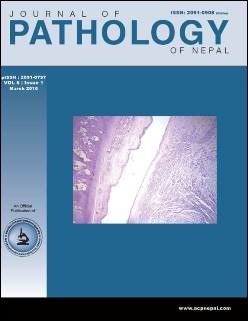Megakaryocytic alterations in thrombocytopenia: A bone marrow aspiration study
DOI:
https://doi.org/10.3126/jpn.v6i11.15673Keywords:
Megakaryocytes, ThrombocytopeniaAbstract
Background: Megakaryocyte morphology plays an important role in thrombopoiesis. A defect in any stage of megakaryocytopoiesis can lead to dysmegakaryocytopoiesis and thrombocytopenia. This study was conducted to understand megakaryocytic alterations and their contribution in the diagnosis of cases of thrombocytopenia.
Materials and Methods: This was a cross-sectional study was conducted on all consecutive cases of bone marrow aspirates of thrombocytopenia over a duration of one year in BPKIHS. Megakaryocyte morphology was studied with a 100X objective. Data were entered into Microsoft excel 10 and analysed with SPSS version 11.5. Descriptive statistics charted and Chi-square tests were done for inferential statistics to find any association at 95% Confidence Interval.
Results: Among the 38 subjects, megakaryocytic thrombocytopenia (44.7%) was the most common cause of thrombocytopenia. Hypolobated megakaryocytes (63.2%), bare megakaryocytic nuclei (57.9%) were the common morphological changes in megakaryocytes. Odds of increased megakaryocyte count in megakaryocytic thrombocytopenia was found to be 12.5 times than for other causes of thrombocytopenia and the presence of bare megakaryocytic nuclei in MTP was statistically significant. (p –value<0.05)
Conclusion: Many similarities were observed in megakaryocytic morphology among different hematological diseases. However, increased megakaryocyte count and presence of bare megakaryocytic nuclei, hypolobated forms were significant in megakaryocytic thrombocytopenia.
Downloads
Downloads
Published
How to Cite
Issue
Section
License
This license enables reusers to distribute, remix, adapt, and build upon the material in any medium or format, so long as attribution is given to the creator. The license allows for commercial use.




